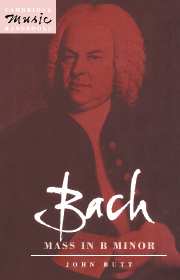Book contents
- Frontmatter
- Contents
- Preface
- List of abbreviations
- 1 The musical genre of the mass Ordinary
- 2 Genesis and purpose
- 3 Reception history
- 4 Text and music: the process of adaptation and composition
- 5 Ritornello forms
- 6 The influence of the dance
- 7 Counterpoint
- 8 Figurae and the motivic texture
- 9 Patterns and proportions: large-scale structuring and continuity in the Mass in B Minor
- Afterword
- Notes
- Select bibliography
- Index
8 - Figurae and the motivic texture
Published online by Cambridge University Press: 05 June 2012
- Frontmatter
- Contents
- Preface
- List of abbreviations
- 1 The musical genre of the mass Ordinary
- 2 Genesis and purpose
- 3 Reception history
- 4 Text and music: the process of adaptation and composition
- 5 Ritornello forms
- 6 The influence of the dance
- 7 Counterpoint
- 8 Figurae and the motivic texture
- 9 Patterns and proportions: large-scale structuring and continuity in the Mass in B Minor
- Afterword
- Notes
- Select bibliography
- Index
Summary
This chapter focuses on the expressive surface of the musical texture: the figurae, or ornamental figures, which constitute the basic motivic content of each piece. It is with this matter that general – and particularly theologically-based – studies of Bach's vocal works most often concern themselves, since the basic figuration so frequently establishes the affekt or mood of the music. Many elements of symbolism, rhetoric and word-painting (other than numerology) are to be found in the surface material of the music, the foreground which immediately distinguishes one piece from another. Although many music analysts would view this level of the structure as the least fundamental to an appreciation of how the music works, it is a mistake to underestimate the importance of the motivic texture. First the figures are historically important, since composers and theorists of Bach's time viewed music as a complex discussion of motives rather akin to rhetoric. Secondly an examination of Bach's treatment of the figural fabric shows exactly the same tendencies which are evident at the ‘deeper’ levels: economy, balance, proportion and a subtle control of momentum.
Figurae play an important role in distinguishing movements in ‘modern’ Baroque style from those in the stile antico. The late sixteenth-century idiom admitted only a few ‘primary’ figures to ornament the notated texture (performers, of course, could improvise considerably more): the transitus or unaccented passing note (consonant or dissonant), which can be placed between two structural notes; certain elaborations of transitus figures (e.g. the cambiata); structural dissonance caused by syncopation (suspension).
- Type
- Chapter
- Information
- Bach: Mass in B Minor , pp. 84 - 91Publisher: Cambridge University PressPrint publication year: 1991

